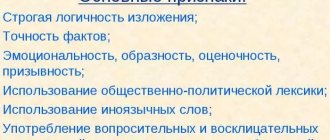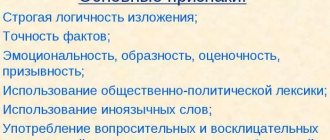A conversational style of speech is on the agenda. If you take and record our everyday conversation, you will most likely get a pun, or, better said, nothing good will come out of this idea at all. Those norms that are applicable for book speech may be completely unsuitable for colloquial speech.
In this article you will learn what a conversational style of speech is, what function it performs, read about the characteristic features, features and genres of a conversational style, and also find examples of this functional style of speech.
What is a conversational style of speech, its main function and scope of application
Conversational style of speech is a functional style, the main task of which is the direct transmission of information in an informal setting, most often in oral form (exceptions may be diary entries, notes, personal letters).
Thus, the main function of the conversational style is the communication function, which provides everyday, everyday connections between people.
The scope of application of this style is everyday relationships: in the family, among friends and acquaintances, communication with colleagues, in a store, on the street and in any other informal and informal setting.
In addition, the colloquial style of speech is found in artistic and journalistic styles for the purpose of reliable and realistic transmission, for example, a report from the scene of an event or to create the necessary atmosphere, character and appearance of a literary hero.
Read the articles:
- “Features, features, genres and examples of scientific style of speech.”
- “Features, characteristics, genres and examples of texts of official business style of speech.”
To design presentations, printed materials, publications, create logos, business cards or infographics, I recommend using the Canva program. This is a very simple and convenient all-in-one visual editor. With thousands of professional templates, images, and other quality elements, you'll get a great starting point to bring your best ideas to life.
Lexical means
Of course, colloquial speech has the most striking differences due to the abundance of special words in it, which are acceptable and appropriate only here. The linguistic palette of everyday style is bright and varied due to its richness in emotions. Often, familiar literary and artistic means and techniques are not enough to express the full range of feelings:
- Wide use of stress, intonation, changes in timbre and rhythm of the voice to add additional color to speech.
- An abundance of colloquial vocabulary, vernacular, jargon, vulgarisms (right now, hot, hard worker, minibus, mobile, cash).
READ Ways to increase your vocabulary: from reading books to linguistic games
- Frequent phraseological phrases that are in the nature of evaluative generalizations (the hunchbacked grave will correct), the use of words in a figurative meaning (window - break, hat - mistake).
- The merging of a word with its meaning or assessment, when it is clear without additional explanation (opener, trickster, good fellow, smart guy).
- The use of words with diminutive or augmentative suffixes (blushing, pretty, little book, little chair).
- Simplification and shortening of long words or names (grade book - grade book). Borrowing foreign language vocabulary (lol, fake, hype). Addition of words (slow-witted, parasite).
- Multi-prefixed verbs with expressive coloring (hold up, don't get enough sleep, throw away).
Vernacular
This group of words and expressions does not fit into the norms and framework of literary speech. It carries shades of simplification, rudeness, and reduction of meaning.
Some scientists distinguish vernaculars into a separate lower layer of vocabulary, since they are used by people to convey a special attitude towards a subject or object, that is, they act as a full-fledged stylistic linguistic unit. The second group of researchers classifies vernaculars as a special group that goes beyond the literary language.
The use of colloquial words is deliberate when it is included in the narrative by educated people in order to give the story a special tone, specific coloring, and imagery. This is what publicists, journalists, speakers, and politicians do. In addition, this is found everywhere in the everyday speech of the average city resident. But even those deprived of education can use vernaculars. This situation is already deliberate in nature, when there is not enough intelligence and vocabulary to express thoughts differently.
Colloquial speeches are quickly remembered due to their vivid meanings. They are individual, often do not have synonyms, related or cognate words.
Jargonisms
In modern Russian, there are three groups of slang words: youth slang, professional slang (among workers' organizations - construction workers, factory workers, truck drivers) and camp or prison slang (it is used in prisons).
READ How to learn to speak beautifully: techniques, methods and tips
Slang is most widespread in everyday speech. The sources of its occurrence are considered to be student communities, schools, and gymnasiums. Its appearance is associated with the desire of young people to stand out and be different from those around them. All slang words have synonyms in the literary language (dormitory - hostel, correspondence - distance learning, kurach - course work, teacher - teacher). Jargon also includes words that convey the attitude or state of the speaker (high, awesome, laugh, labor, cool).
Vulgarisms
These are the most brightly colored words allowed in speech. Vulgarisms are rude, aggressive or even vulgar in nature. They are far beyond the boundaries of literary language, but their use is sometimes acceptable as an additional artistic device.
Vulgarisms include all curses, abusive expressions, words that convey strong negative emotions, taboo words and blasphemy (die - die, lupals - eyes, eat - eat, muzzle - face).
The presence of a large number of vulgarisms in speech indicates a low culture of behavior, lack of education and spirituality.
Characteristics and features of conversational style
The characteristic features include :
- Oral form of speech.
- Informality and ease.
- Emotionality (in the form of a live reaction to people’s words and actions).
- Specificity.
- Simplicity and ordinariness of content.
- Use of colloquial vocabulary with a colloquial flavor.
In addition to the above characteristics, the conversational style of speech has a number of features and distinctive features :
- Most often it is implemented in the form of dialogue.
- Language material is not pre-selected.
- Facial expressions, gestures, and the surrounding environment are of great importance.
- Words are used in a figurative sense, there are incomplete sentences, addresses, interjections and particles, repetitions of words.
- The use of emotional words and expressions (nightmare, horror, victory, this is wonderful, etc.).
- Disorganized and fragmented speech (“A kilogram of apples, please.”).
- Intonation plays a special role: raising or lowering the tone, stretching vowels, pauses, changing the tempo of speech.
- Colloquial style vocabulary consists of common words (work, read, book, metro) and colloquial words (potato, giggle, butuz, scribble, hype).
- There are slang words (to fill up a place), colloquial words (dreary, sleepy, crazy) and slang words (teacher), professionalisms (non-cash, cash, turn on the meter), dialecticisms (pitching - duck, kuren - hut).
- Terminological, abstract vocabulary, as well as book words are almost not used.
- Law of economy of speech means. Very often, instead of two words, one is used: condensed milk - condensed milk, sick leave - sick leave; stable combinations are simplified: maternity leave - maternity leave.
- The conversational style is rich in phraseological units: sewn with white thread, touch a nerve, just a stone's throw away.
- To enhance emotionality, doubling of words is used, sometimes with exaggeration: big-very big, black-black water, quiet-quiet.
- Lots of pronouns (I, you, we) and verbs.
- Participles and gerunds almost never occur.
Morphological features
The form, structure and frequency of use of words in colloquial speech often contradict the rules of the Russian language. But this makes the style of everyday communication unique and recognizable:
- There is a tendency not to decline the first name in combination with the surname (Semyon Semenychu), some numerals (from two hundred and forty-eight). On the contrary, indeclinable abbreviations and abbreviated names are declined (in the registry office).
- Possessive adjectives are popular (Sashka’s girlfriend, fireman’s wife).
- The primacy of verbs over nouns. Frequent use of particles and verbal interjections (boom, jump, grab).
- Nouns are used in the genitive or prepositional case ending in -u (in the workshop, give me some tea, back from vacation).
- Verb tenses are blurred. Past and future tenses are used to mean the present.
- A large number of personal and demonstrative pronouns.
- The use of imperative interjections to fully convey the feelings experienced.
- Repeating certain words to create emphasis.
- Using inversion to enhance the meaning of a particular word.
Conversational style of speech: genres
Depending on the situation at the time of communication, the following genres (varieties) of conversational style of speech in oral form are distinguished:
- Conversation (conversation).
- Phone conversation.
Genres of conversational style in writing:
- A note.
- Communication via the Internet.
- SMS.
- Private letters.
- Entries in a personal diary.
Of course, the main genre of conversational style of speech is conversation or conversation. Depending on the number of participants, this may be a dialogue or monologue.
Dialogue is an exchange of remarks, questions and answers between two or more people. Dialogue is characterized by frequent changes of roles “speaker – listener”, so that the interlocutors alternately act in one or another role. Replies can also express addition, clarification, extension, agreement, objection, encouragement, etc.
Monologue is speech in the first person, addressed to the listener or to oneself, not intended for a response.
In a conversational style, dialogue and monologue in their pure form are rarely encountered: a monologue can be interrupted by remarks from the interlocutors, and the dialogue, in turn, can include mini-monologues and micro-stories.
Linguistic features of everyday language
Features of the conversational style of speech lie primarily in pronunciation. Often people put the wrong emphasis, which is unacceptable for more rigorous texts, for example, written in a scientific style.
Lexical features
Lexical features in colloquial speech indicate the ease of communication and its expressive flavor. During a conversation, people often change words in one part or another, for example, they say angry, smart, wise, sarcastic, jabber, bother, quietly, little by little, well, and so on.
In everyday speech, phraseological units are often used, because a person has a dominant way of thinking in everyday communication. Observing some phenomenon, he makes a generalization. Examples: “There is no smoke without fire”, “The grave will straighten the hunchback”, “Slower than water, lower than the grass” and so on.
The linguistic features of the conversational style also lie in the fact that this style of text has its own word formation. Nouns often change their suffixes, for example, good man, old man, huckster, reveler, feeder, and so on.
A conversational style text may also contain words that designate feminine persons by their specialty, position, occupation, for example, director, secretary, doctor. In addition, there are suffixes of subjective assessment, thanks to which the message acquires the greatest color, for example, thief, naughty girl, little house, feisty and others.
Colloquial adjectives can also change their suffixes like this: big-eyed, big-tongued. In addition, people often apply the prefix “pre” to adjectives, resulting in pre-kind, pre-nice, pre-unpleasant, and so on. Verbs that speak about everyday speech look like this: to misbehave, to wander, to cheat.
Morphological features
Morphological features of the colloquial style of speech imply the use of parts of speech in the wrong case. For example, nouns in the prepositional case: he is on vacation, a plural noun in the nominative or genitive case: agreements, not contracts, several tomatoes, not tomatoes, and so on.
Example text in conversational style
As an example of a conversational style of speech, below are excerpts from the books of the modern (brilliant) writer Fredrik Backman. The spoken language in his works comes out very realistic and lifelike.
An excerpt from Fredrik Backman’s book “Grandmother told me to bow and tell her that she asks for forgiveness”:
Stretching out on the floor, the grandmother rummaged under the bed and pulled out a package. It wasn't meat or cigarettes. These were sweets.
– You must give the chocolate to your Friend.
Several moments passed before Elsa realized which friend she was talking about.
Elsa looked at her grandmother in confusion:
- Bah, are you out of your mind? Do you want my death?
Grandma rolled her eyes.
- Stop being a fool. Are you saying that the knight of Miamas does not dare to go on a mission?
Elsa squinted her eyes offendedly:
- You take it weakly.
- Look at the root! - Grandma grinned.
Excerpt from Fredrik Backman's book Britt-Marie Was Here:
“I’ll sit here until you stop dying.” “If you want to eat, you’ll have lunch,” the Personality grinned and extended her hand to the half-eaten pizza lying on the stool.
- Lunch? Now? – Britt-Marie muttered, because it wasn’t even eleven.
- Do you want to eat? Here's pizza! – invited the Personality.
Only now did what was said reach Britt-Marie's consciousness.
– What do you mean “pulled”? Did they shoot at me? – she exhaled, feeling her head in search of an opening.
- Yes Yes Yes. Hit the head with a soccer ball,” the Personality nodded, spilling vodka on the pizza.
Judging by the look of Britt-Marie, she would prefer a gun to a ball. As a less dirty item.
PS: Did you like the article? Share the link on social networks! Thanks and have a nice day.
Sources used:
- E. Demidova “Style... Style... Style...”.
- GIA. Russian language. Universal reference book. Author: Angelina Rudneva.
- resh.edu.ru
- Photo - dreamstime.com
Differences between colloquialism, slang and jargon
Colloquial speech is similar to slang and jargon, as they are two other ways of informal communication.
The difference is that slang words are used by certain social groups, such as teenagers, while colloquial expressions can usually be understood across age and socioeconomic barriers if all speakers are in the same geographic region.
Colloquial vocabulary may contain elements of jargon, but this is not always the case.
Like slang, jargon is used only by certain groups, but it often refers to words used in a particular profession. For example, the way lawyers speak is so specific to their profession that it is often called "legal."
Other professions that rely on the exchange of complex information also use jargon, such as scientists, doctors, and businessmen.
Functions of spoken language:
- transfer of information;
- communication;
- narration;
- artistic coloring of the text;
- stylistic turns.
Trends in the development of conversational style of speech show a high rate of integration of slang and phraseological units, and pragmatics and stylistics of everyday speech are gaining popularity in all types of information sources. The simpler the better.
The meaning of colloquialism in literature
The authors will often use everyday expressions to make the dialogue sound more authentic.
For example, a contemporary novel author would probably choose the greeting "Hey, how are you doing" rather than "Good afternoon."
They can also use this structure to situate the writing more decisively in a specific time period and/or place. Conversational speech allows you to do this.
When used improperly, everyday expressions often become unpleasant for the reader. In fact, authors should avoid excessive use of dialect, such as distorting words for the purpose of shortening (“now” - “right now”) in colloquial culture.
However, when used correctly, readers can feel trust in the author. Writers may also unconsciously use colloquialisms if they are not accustomed to business mannerisms. The stylistic features of the conversational style will be discussed below.
Scientific style of writing text
Scientific style of storytelling
To determine this style in a text, you need to know its signs and features. Such features are the use of terms, scientific definitions, foreign expressions and words, a large number of neuter nouns (property, attitude), as well as the lack of emotional connotation. The style is also characterized by the logical expression of thought, which promotes a logical connection between sentences and their individual parts. Scientific text, as a rule, often has complex narrative sentences with a considerable number of adverbial and participial phrases.
Abbreviations
First names and patronymics are used in a truncated form. For example, San Sanych instead of Alexander Alexandrovich. In linguistics, this phenomenon is called prosyopesis. In addition, in everyday speech, “dad” and “mam” are more often used than the words “mom” and “dad”, “mother” and “father”.
In conversation, people actively use aposiopesis, that is, intentionally breaking off a phrase. For example: “But if you’re not home by two, then...” Sometimes authors of literary and journalistic texts also resort to this linguistic device (“If serious changes do not occur in the economy, then...”). But first of all, aposiopesis is characteristic of colloquial speech.
Scheme for performing text parsing point by point
To carry out a stylistic analysis of any text, the following algorithm is used:
- Determine whether there is a main function, what speech tasks there are in the end. Availability of additional functions.
- Highlight the characteristic features.
- By what means can these features be created?
- What genre or scope of application.
- Determine which of these features are inherent in speech: emotionality, imagery, ease, accuracy, vagueness, subjectivity.
- Specifics of speech: phraseology, vocabulary, grammar. (Perhaps give an example passage.)
- Conclusion.










